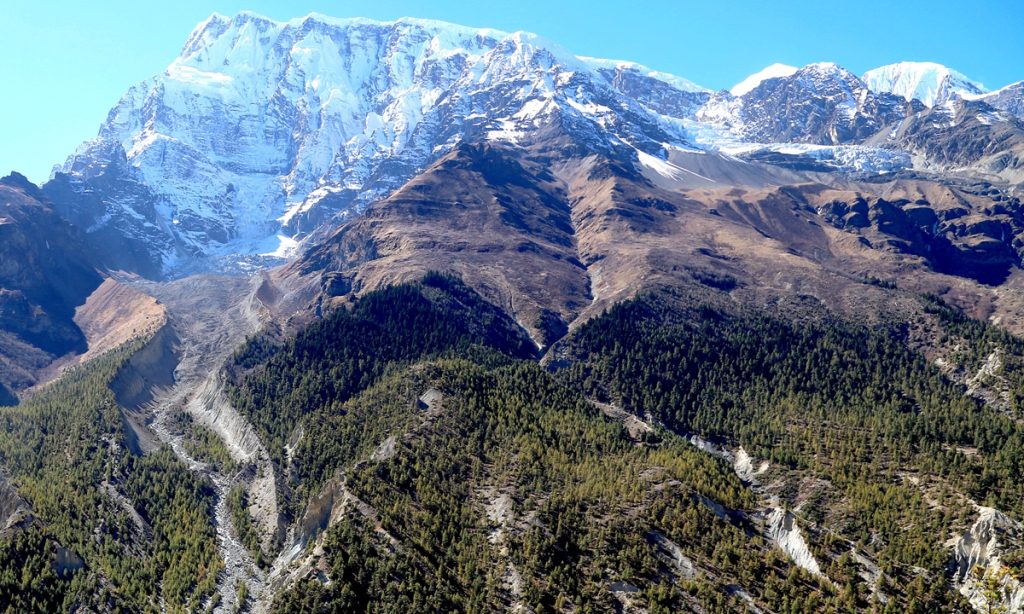Global warming accelerates upward expansion of the alpine tree line in the Himalayas: study

A latest study by researchers from Institute of Tibetan Plateau Research (ITP), Chinese Academy of Sciences (CAS), indicates that, against the backdrop of warming climate over the last 200 years, Abies spectabilis (Himalayan fir) in the mixed forests of Nepal's Sagarmatha National Park and Annapurna Conservation Area is expanding to higher altitudes at a faster rate compared to Betula utilis (Himalayan birch) in the same area. The findings point to accelerating successional dynamics with late-successional species rapidly outcompeting pioneer species, offering insight into future forest succession and its influences on ecosystem services.
The study was conducted by a team led by researcher Liang Eryuan from the State Key Laboratory of Tibetan Plateau Earth System, Environment and Resources, ITP, CAS. It was published online in Nature Plants on Monday, the Global Times learned from the ITP.
Understanding how climate change influences succession is fundamental to predicting future forest composition. Global warming is expected to accelerate species succession at their cold thermal ranges, such as alpine tree lines. In the study, the team examined how interactions and successional strategies of the early-successional birch and the late-successional fir affected tree line dynamics by combining plot data with an individual-based tree line model at tree lines in the central Himalayas, read the study.
The team found that firs showed increasing recruitment and a higher upslope shift rate (1.1 ± 0.2 meter per decade) compared with birch (0.6 ± 0.3 meter per decade) over the last 200 years. Spatial analyses indicate strong interspecies competition when trees were young. Model outputs from various climatic scenarios indicate that firs will probably accelerate their upslope movement with global warming, while birch recruitment will decline drastically, forming stable or even retreating tree lines, according to the study.
Shalik Ram Sigdel, the first author of the study and associate researcher at the ITP, told the Global Times that the alpine tree line, the uppermost limit of continuous distribution of upright trees, is strongly constrained by environmental factors such as low temperatures, making it highly sensitive to global warming. It serves as an ecological transition zone for studying species succession.
Vegetation succession refers to the recovery process of plant communities after disturbances over a long-time scale or the formation and development process on bare ground. Succession theory is one of the core research topics in vegetation ecology, forming the basis for predicting vegetation dynamics under different future climate scenarios and guiding the restoration of degraded ecosystems, according to Sigdel.
Fossil records confirm that birch has been distributed in the Himalayan region for 2.5 million to 5 million years. Dendrochronological analysis indicates that in high-altitude forests composed of a single tree species, the maximum age of birch can exceed 450 years. As a pioneer species following glacial retreat, the succession process of birch should belong to the long-term succession type. However, it remains unclear whether climate warming will accelerate this succession process.
Since 2010, the research team has discovered mixed forests where birch and firs coexist at the tree line in Nepal's Sagarmatha National Park and Annapurna Conservation Area, providing a natural experimental platform for studying forest community succession under warming conditions.
"Birch is sensitive to moisture, and the water stress caused by warming limits its growth and regeneration. In contrast, firs are sensitive to temperature, and warming within a certain threshold range is beneficial for their growth and regeneration. Therefore, against the backdrop of climate warming, firs demonstrate greater competitiveness than birch," said Liang Eryuan, the corresponding author of the study.
Liang emphasized that climate change is significantly accelerating the species succession process at the alpine tree line in the Himalayas.
Through tree line model simulations, the research team further found that with ongoing warming, the ascent of firs will continue to accelerate, while the decline in birch regeneration will lead to a decrease in population density, further restricting the tree line ascent. In high-emission scenarios, there may even be a retreat of the birch tree line, indicating that under warming conditions, firs may rapidly replace birch as the pioneer species, accelerating the succession process. This finding has important implications for the prediction of future forest composition, structure, and ecosystem functions.